Abstract
Some E. coli cause diarrhea by elaborating heat-labile and heat-stable (ST) enterotoxins which stimulate intestinal secretion. E. coli ST's are small peptides which bind to intestinal luminal epithelial cell receptors. The ST receptor, one of a family of receptor-cyclases called guanylyl cyclase C (GC-C), is a membrane spanning protein containing an extracellular binding domain and intracellular protein kinase and catalytic domains. The intestine synthesizes and secretes homologous peptides, guanylin and uroguanylin. The kidney also synthesizes uroguanylin. ST, guanylin or uroguanylin binding to GC-C results in increased cGMP, phosphorylation of the CFTR Cl- channel and secretion. Proguanylin and prouroguanylin circulate in blood and bind to receptors in intestine, kidney, liver, brain etc. In the kidney, they stimulate the excretion of Na+ and K+. Study of GC-C "knock-out" mice reveal that GC-C is important to intestinal salt and water secretion, duodenal bicarbonate secretion, recovery from CCl4-induced liver injury, and to intestinal polyp formation in Min mice lacking GC-C.
Full text
PDF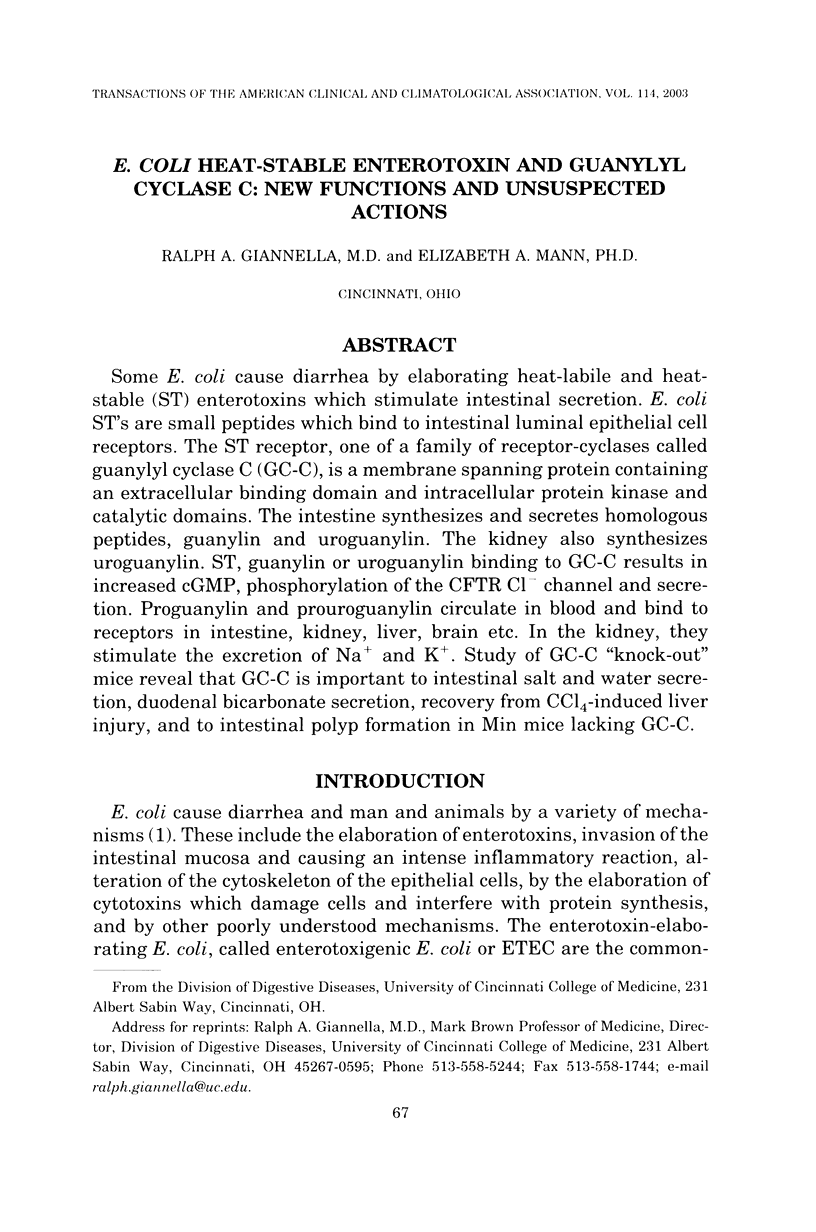
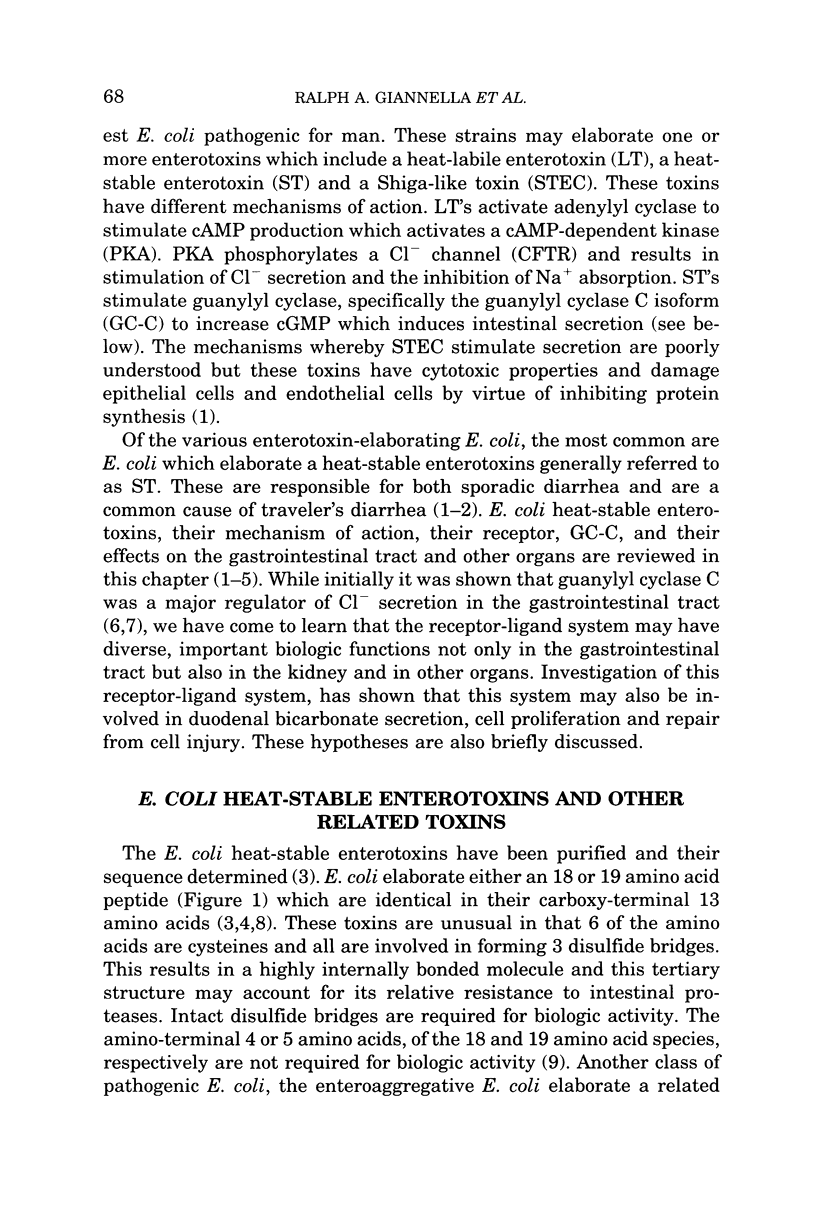
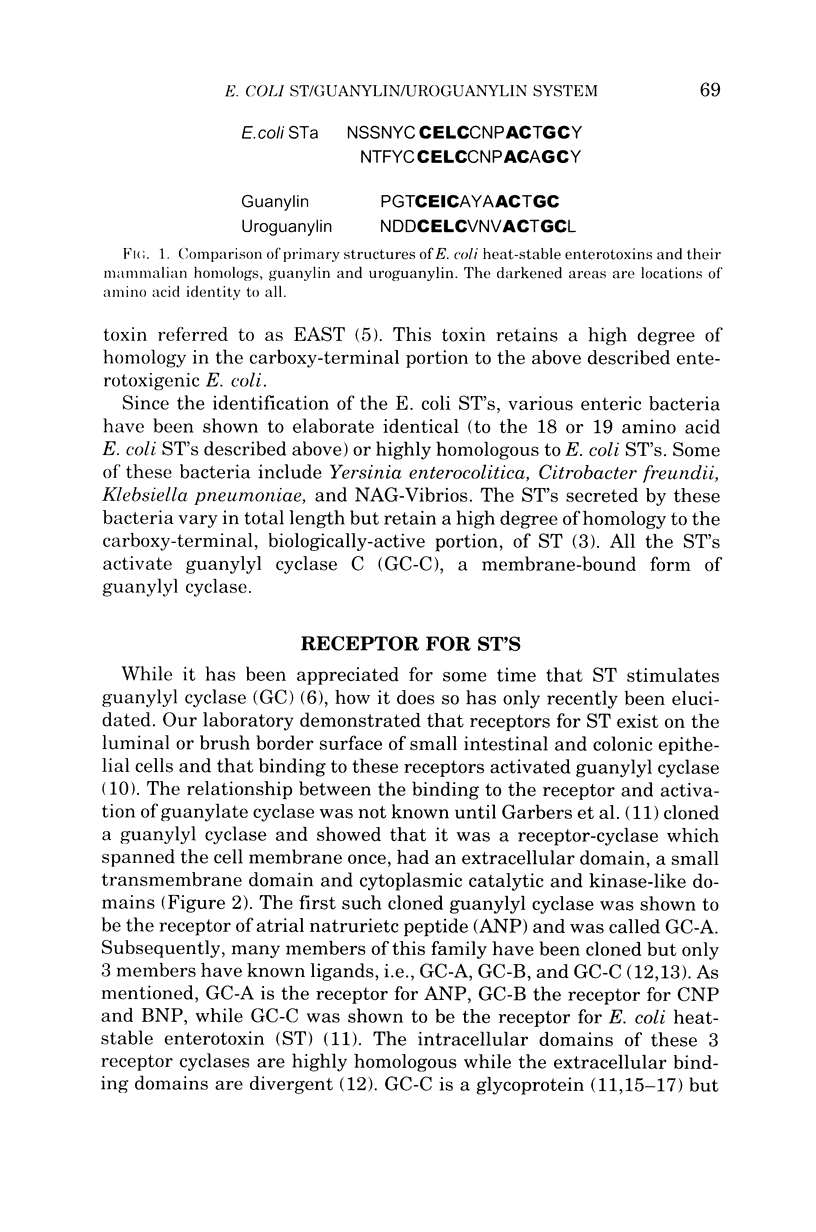
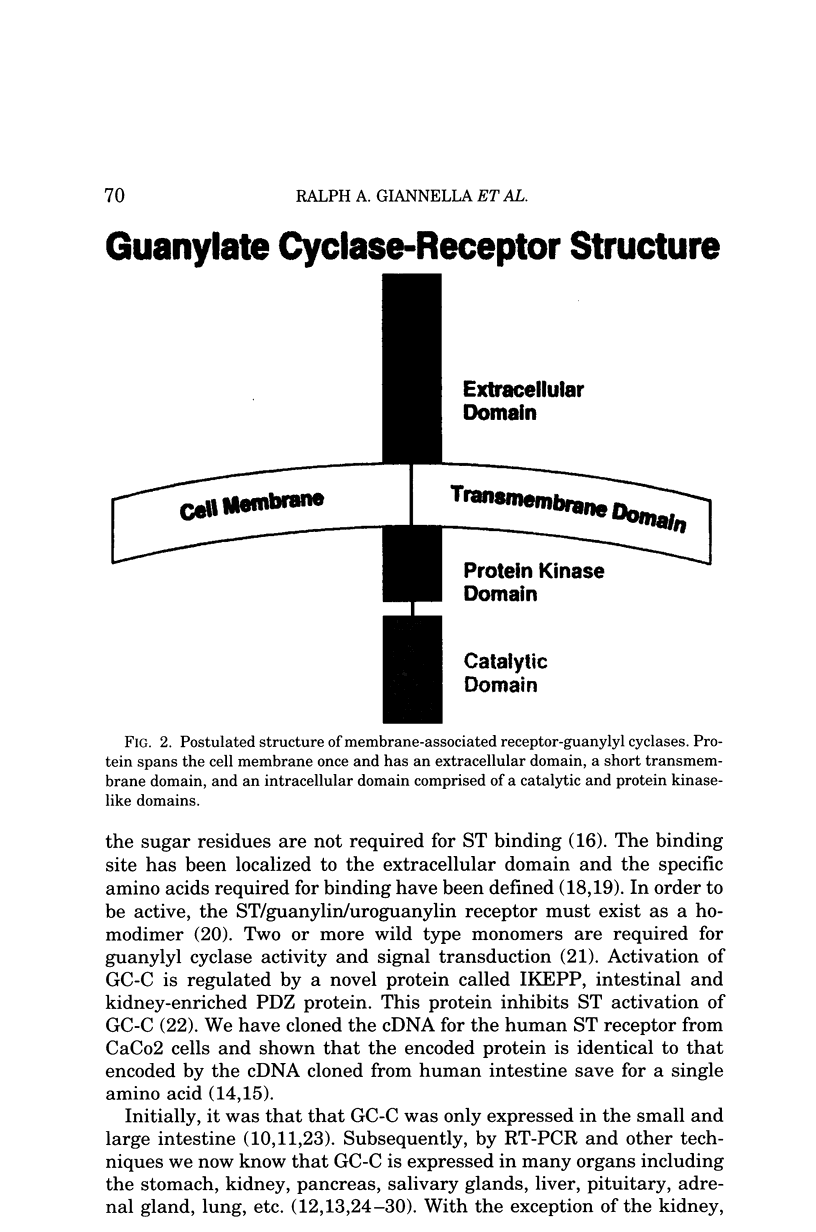
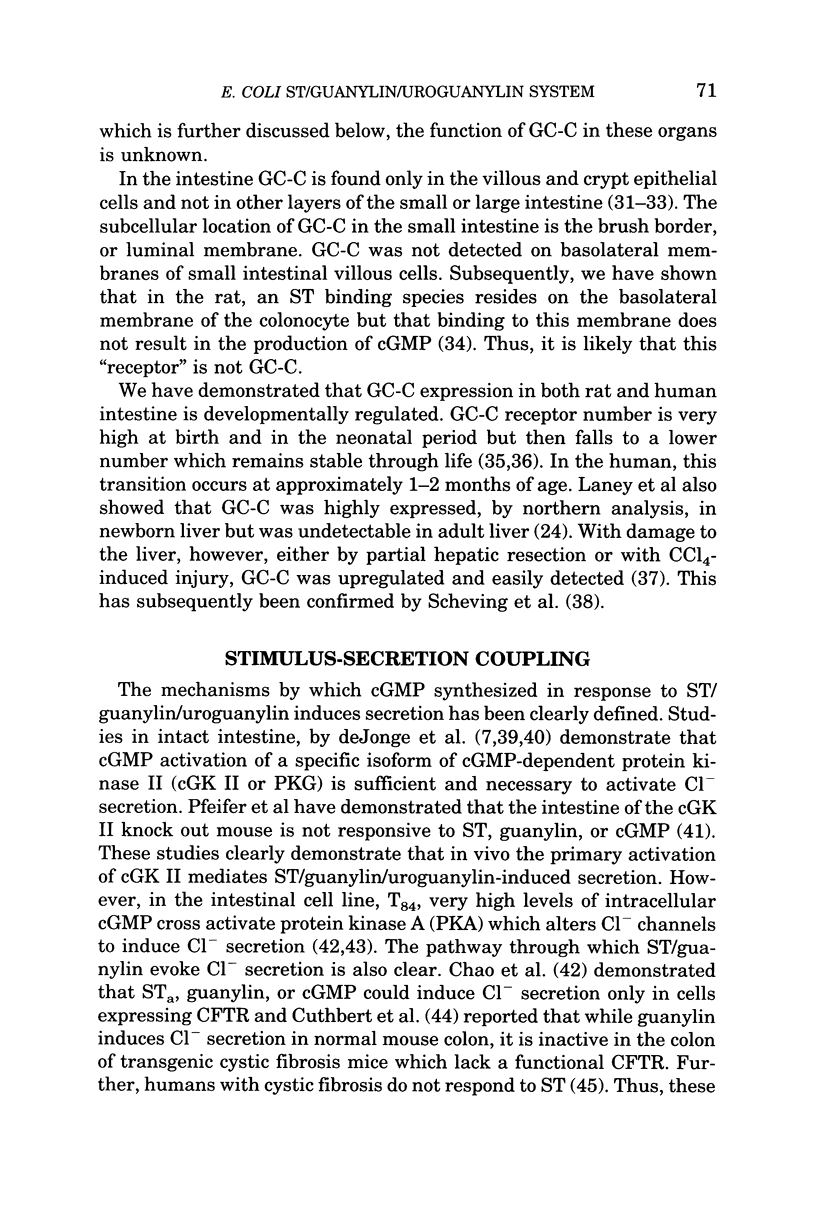
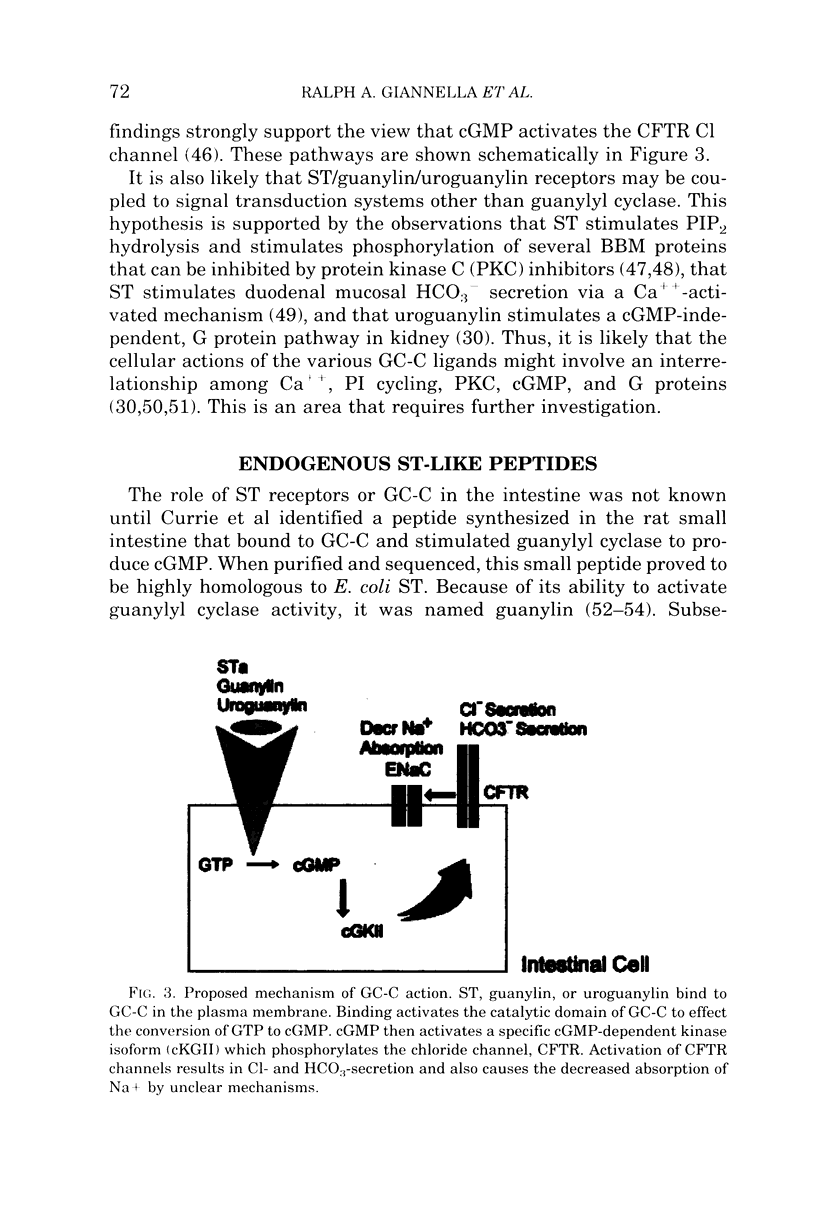
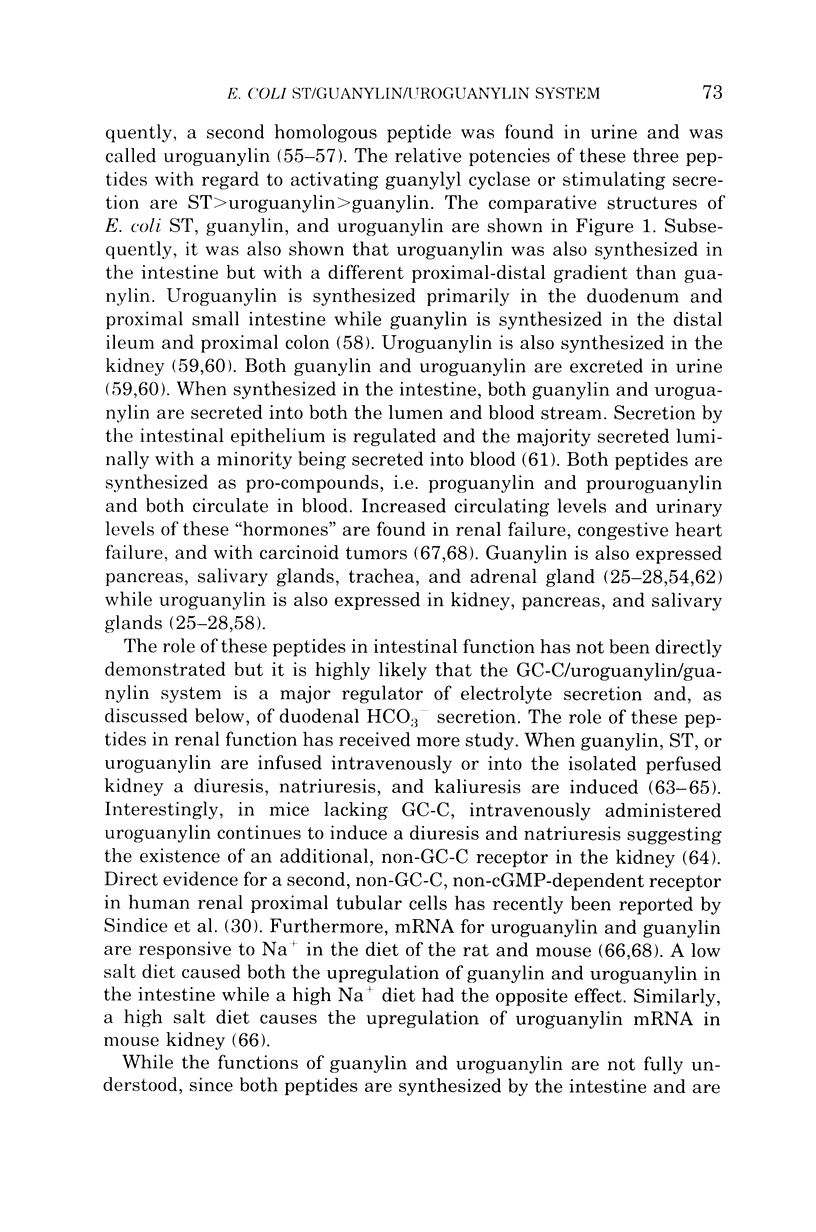
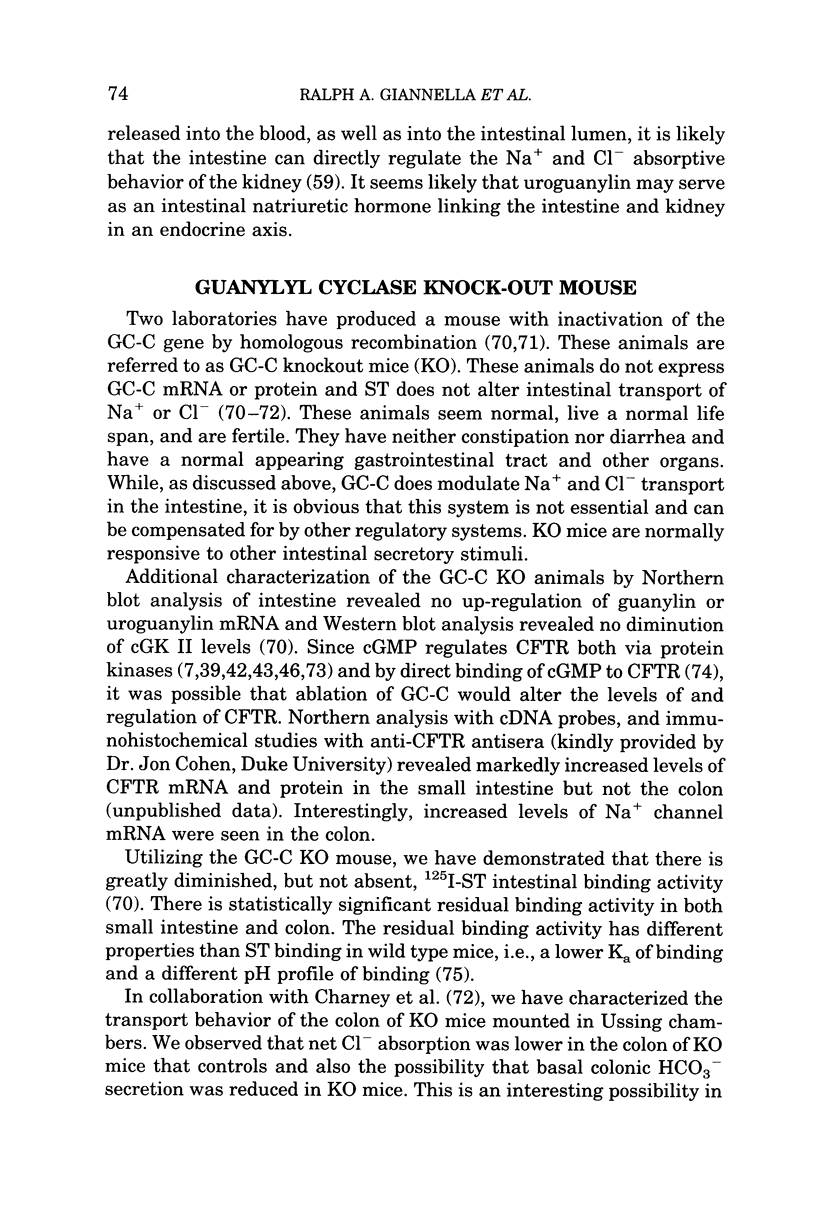
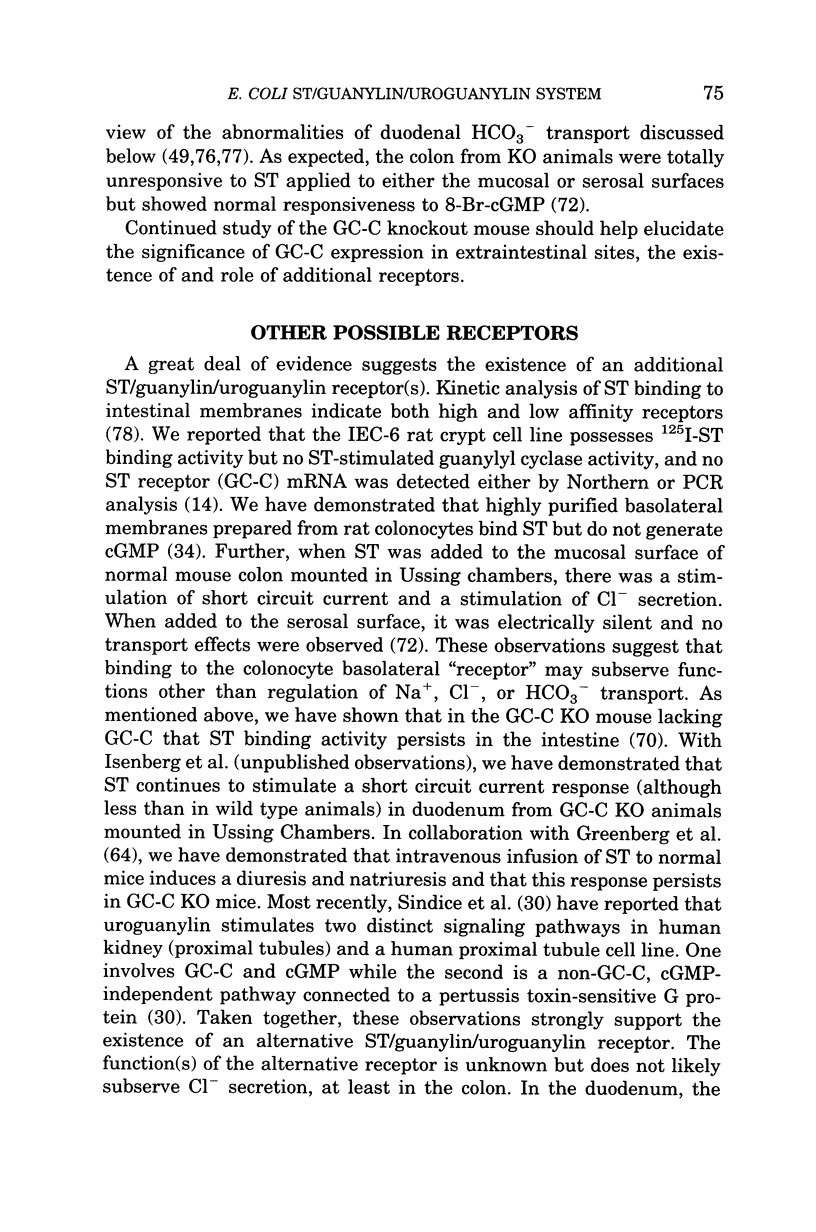
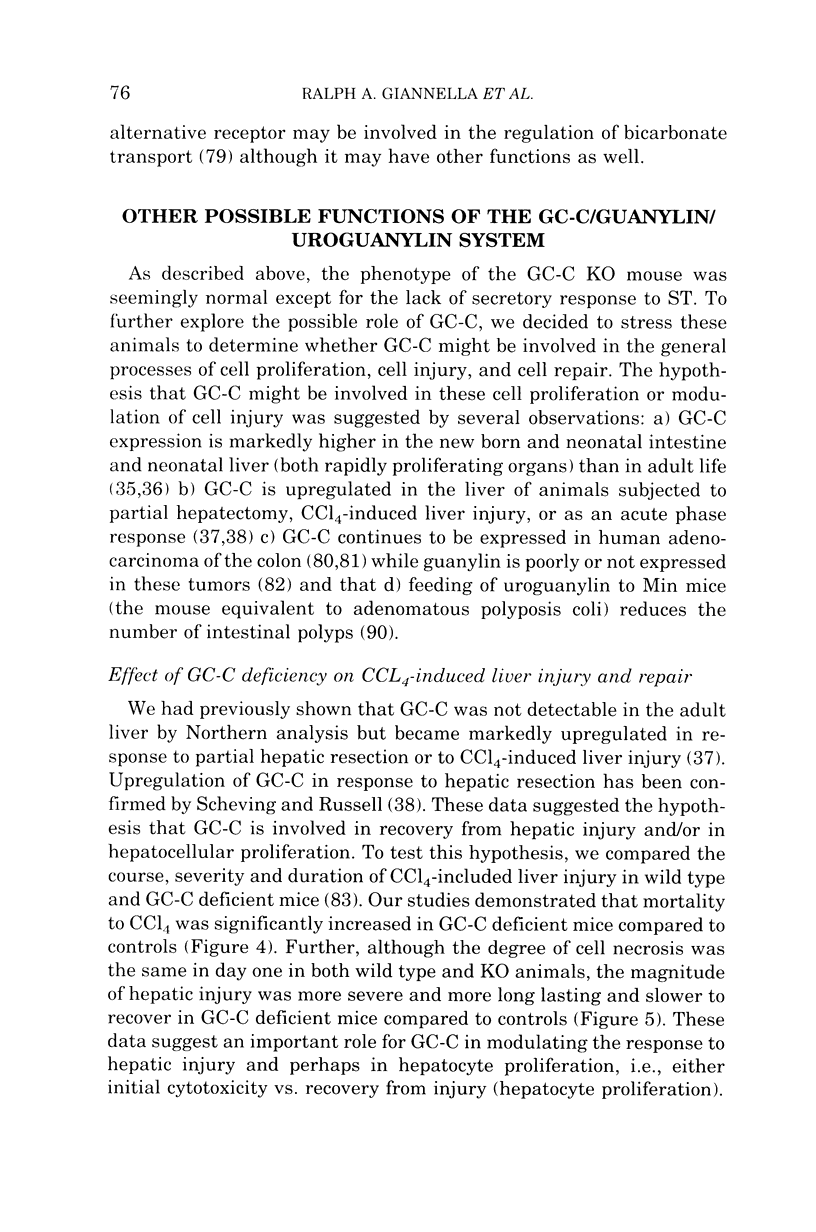

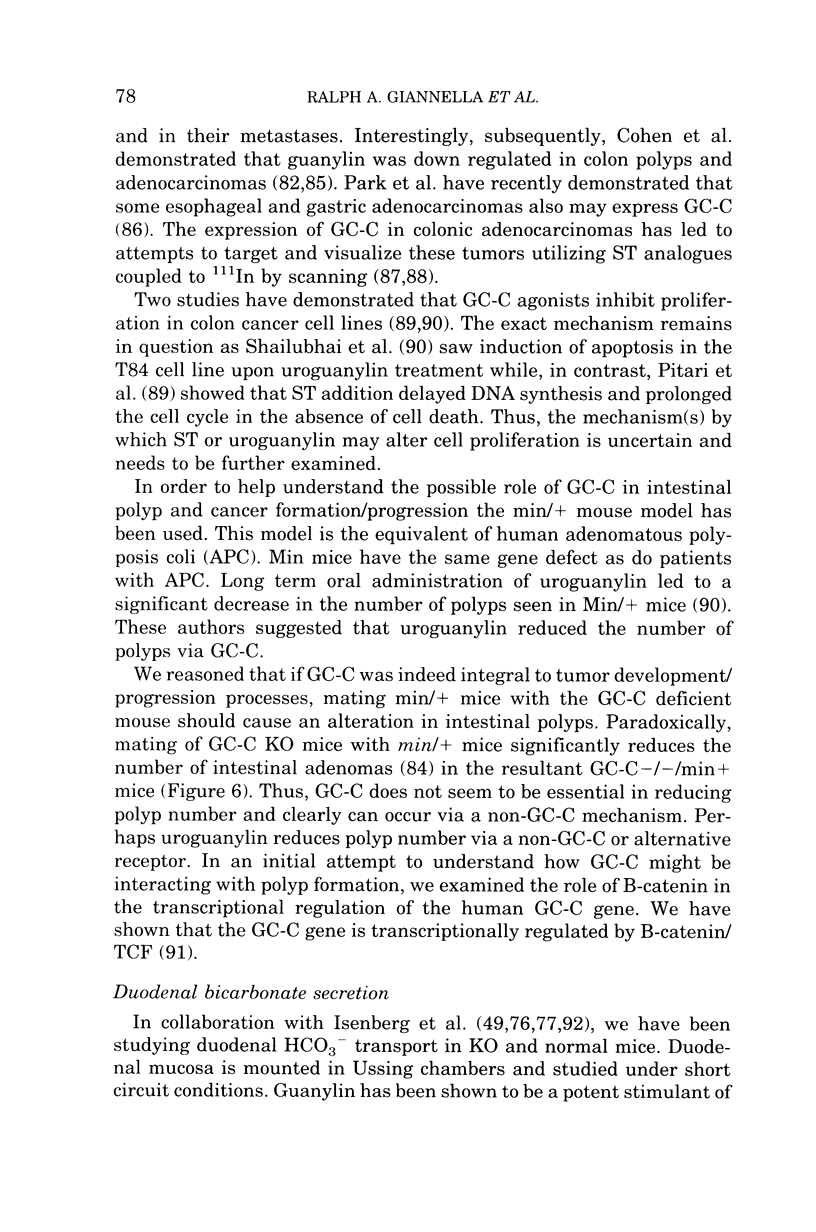
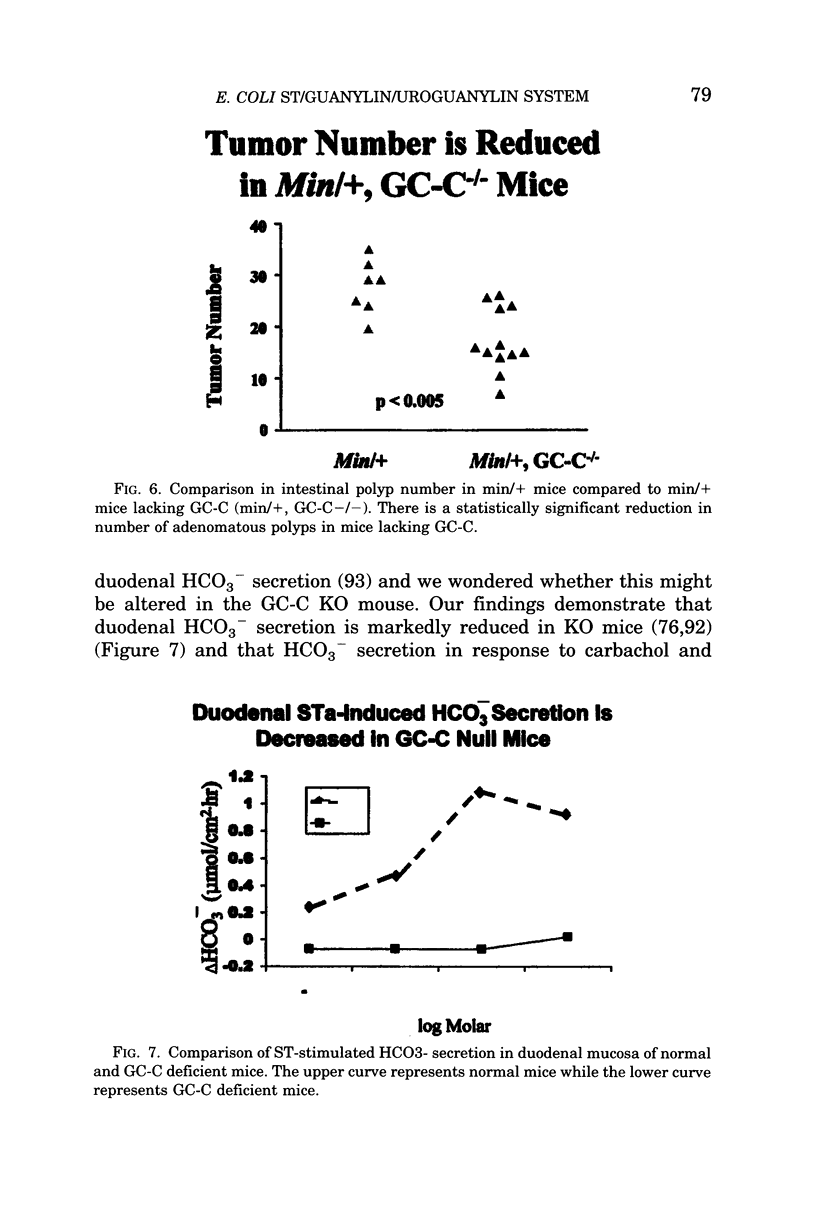
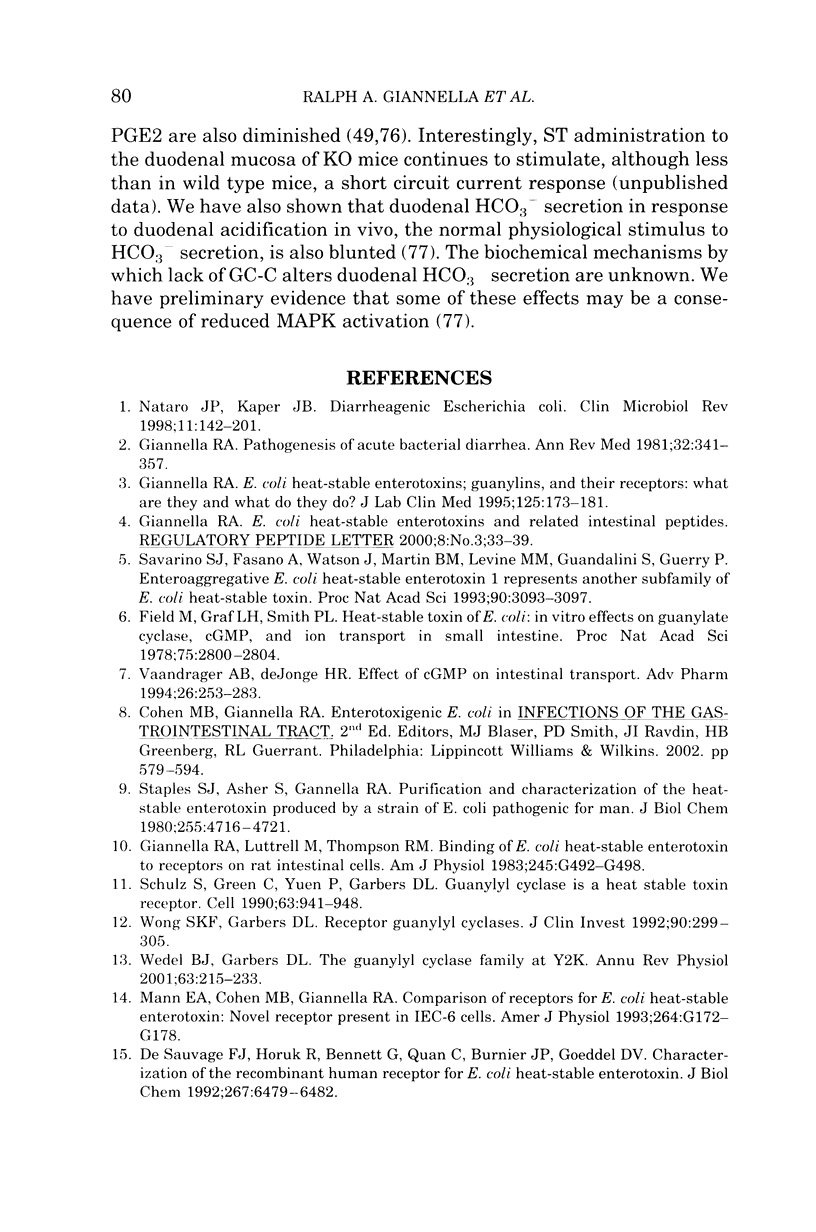
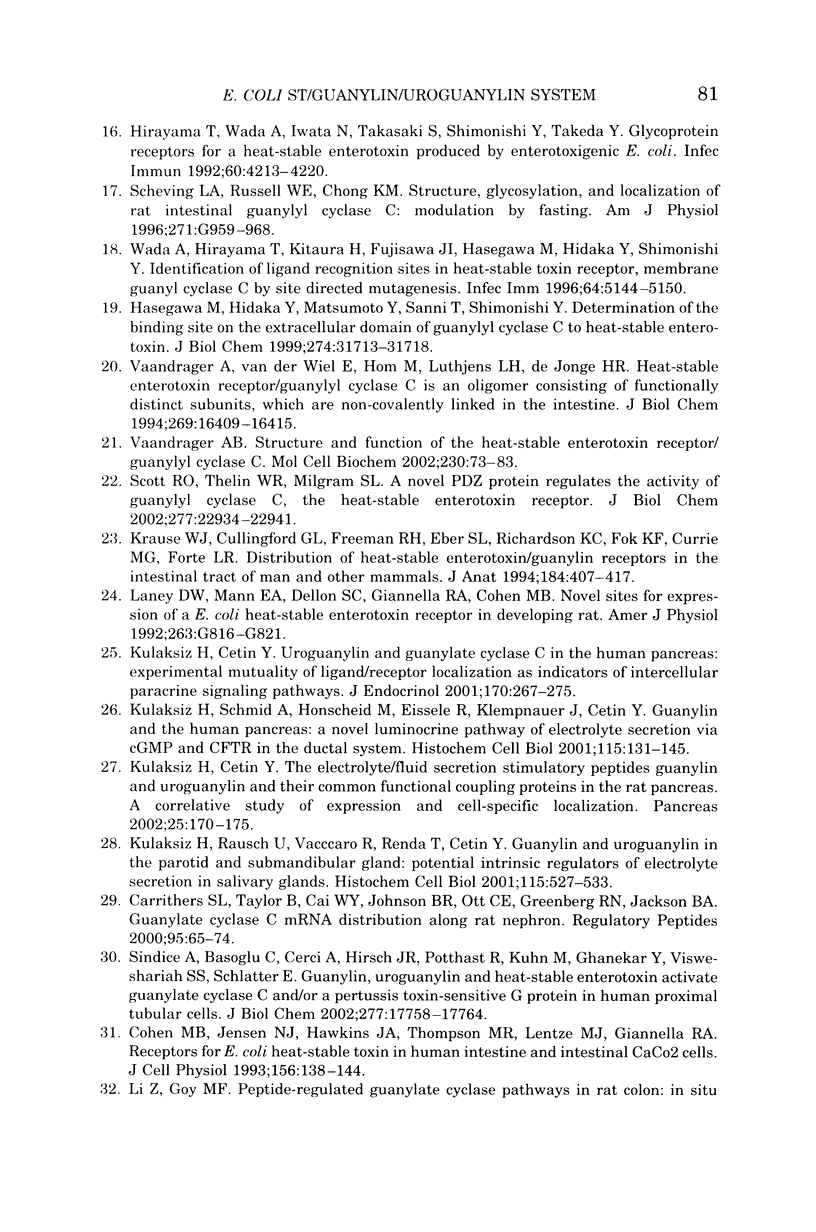
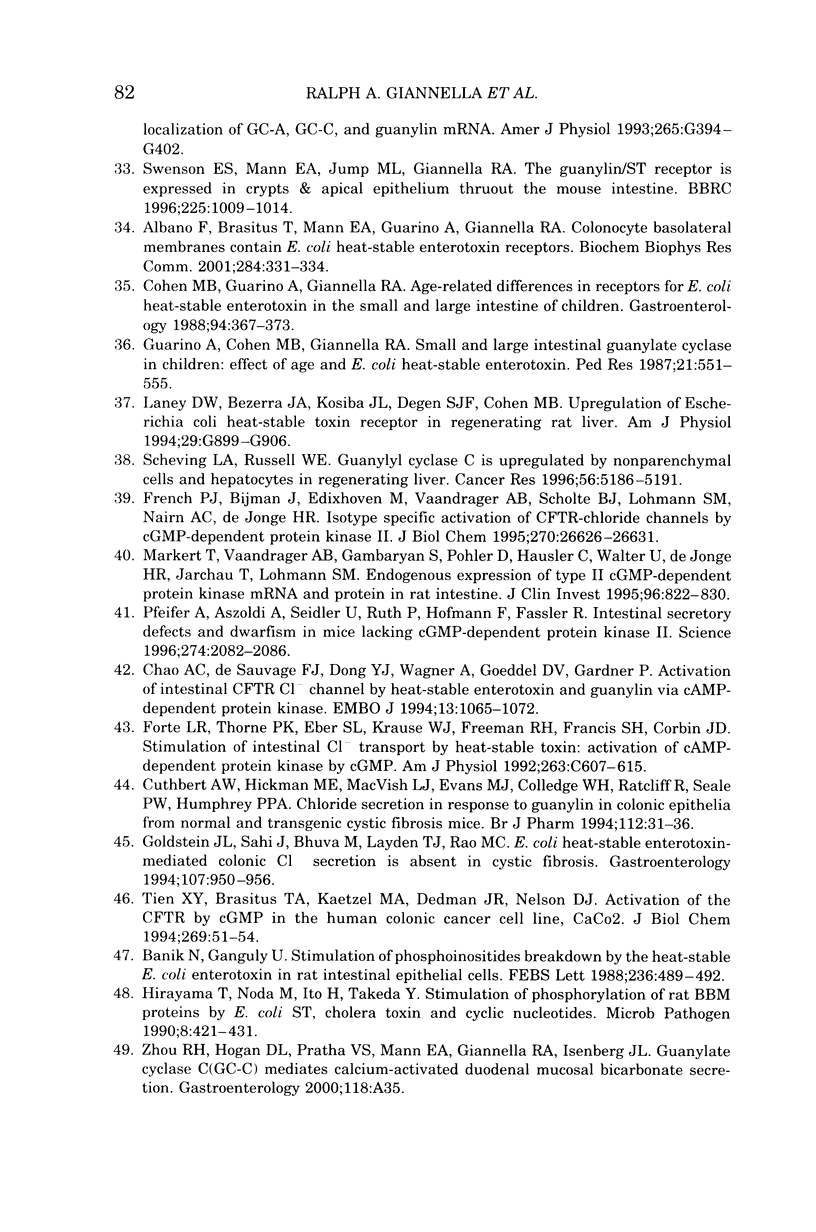
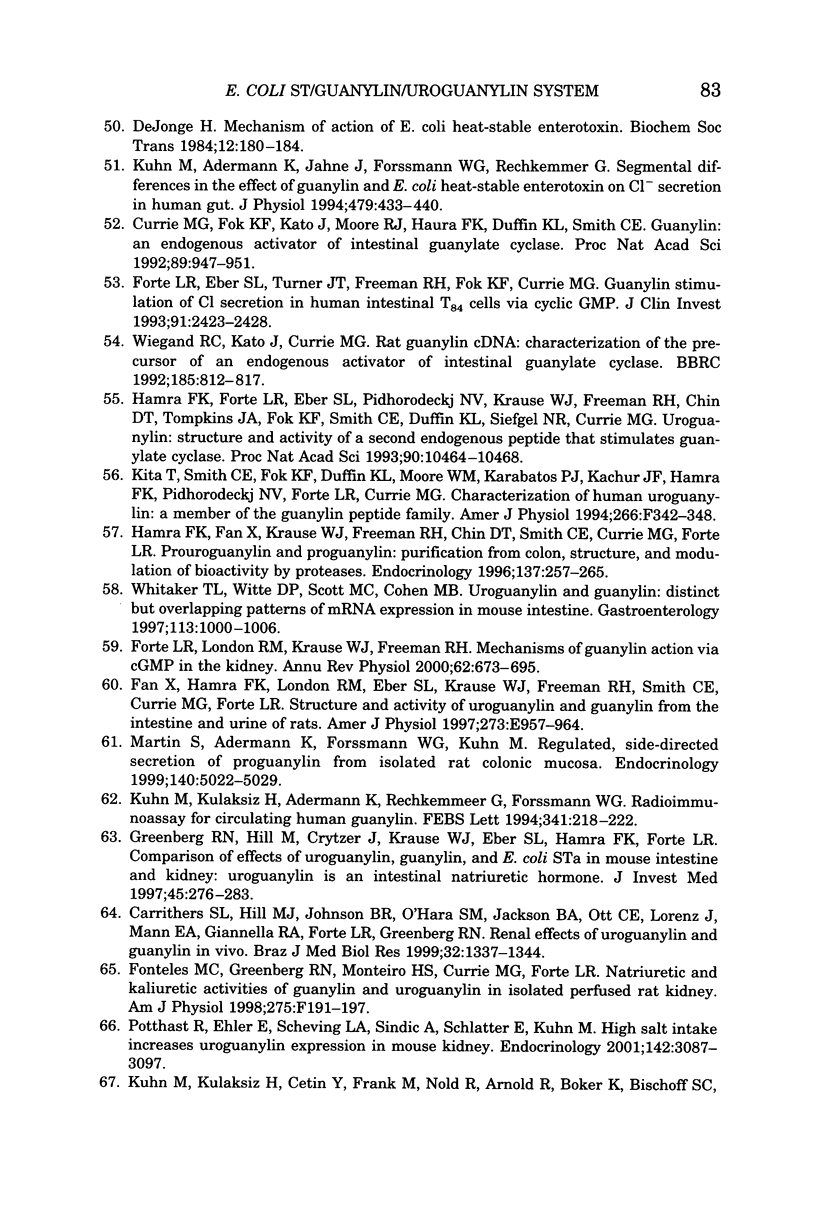
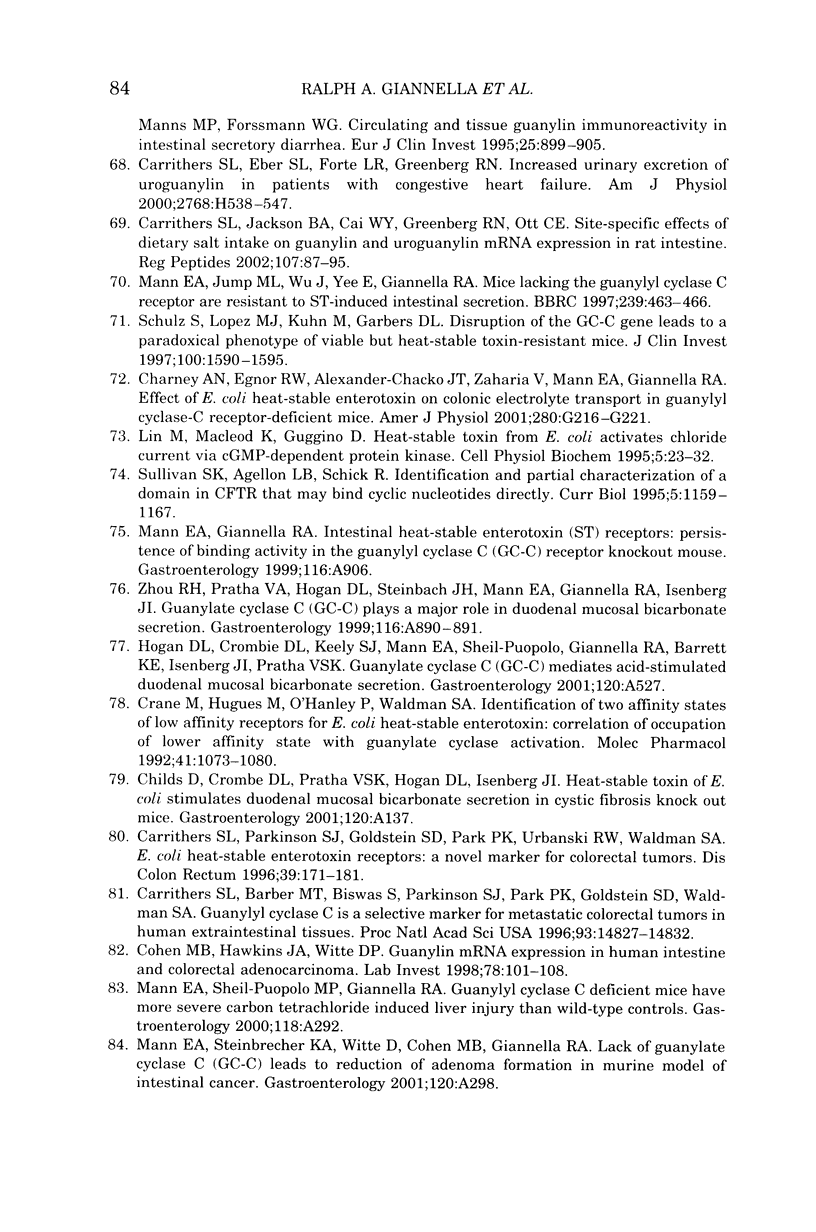
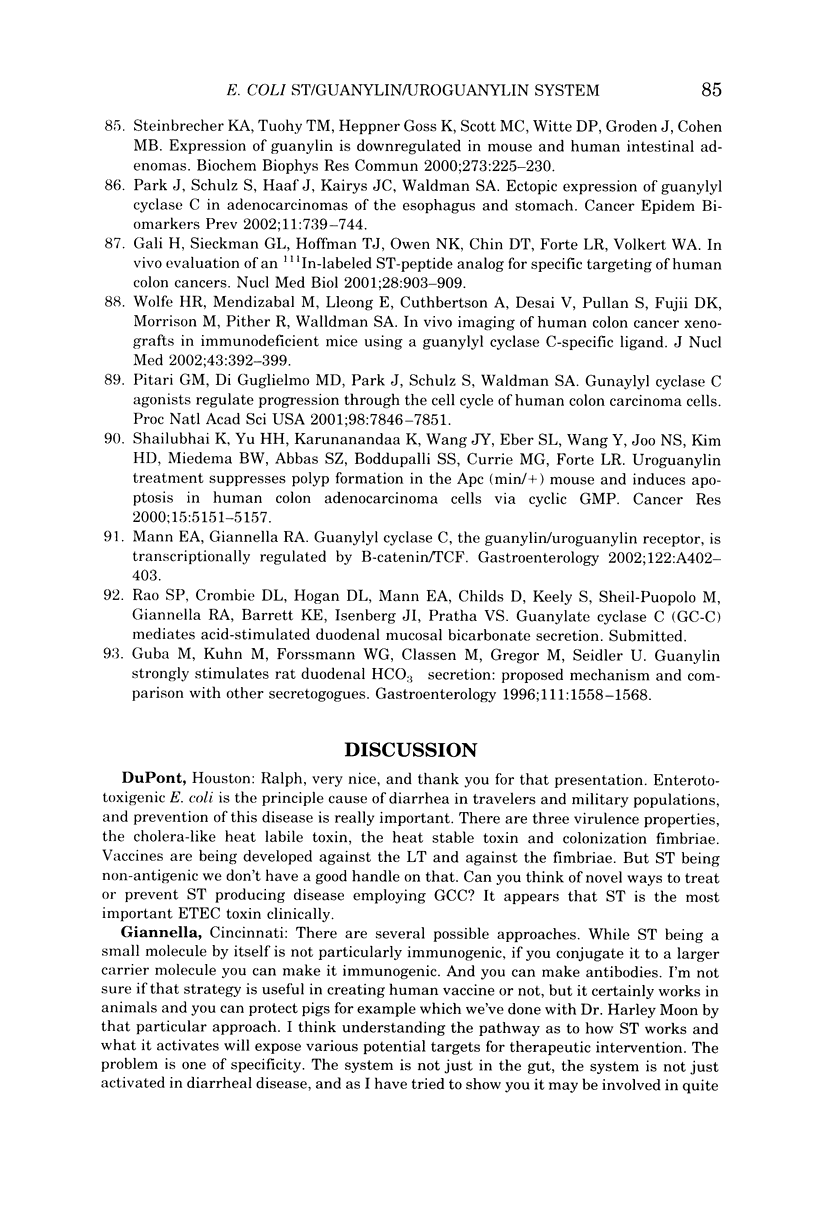
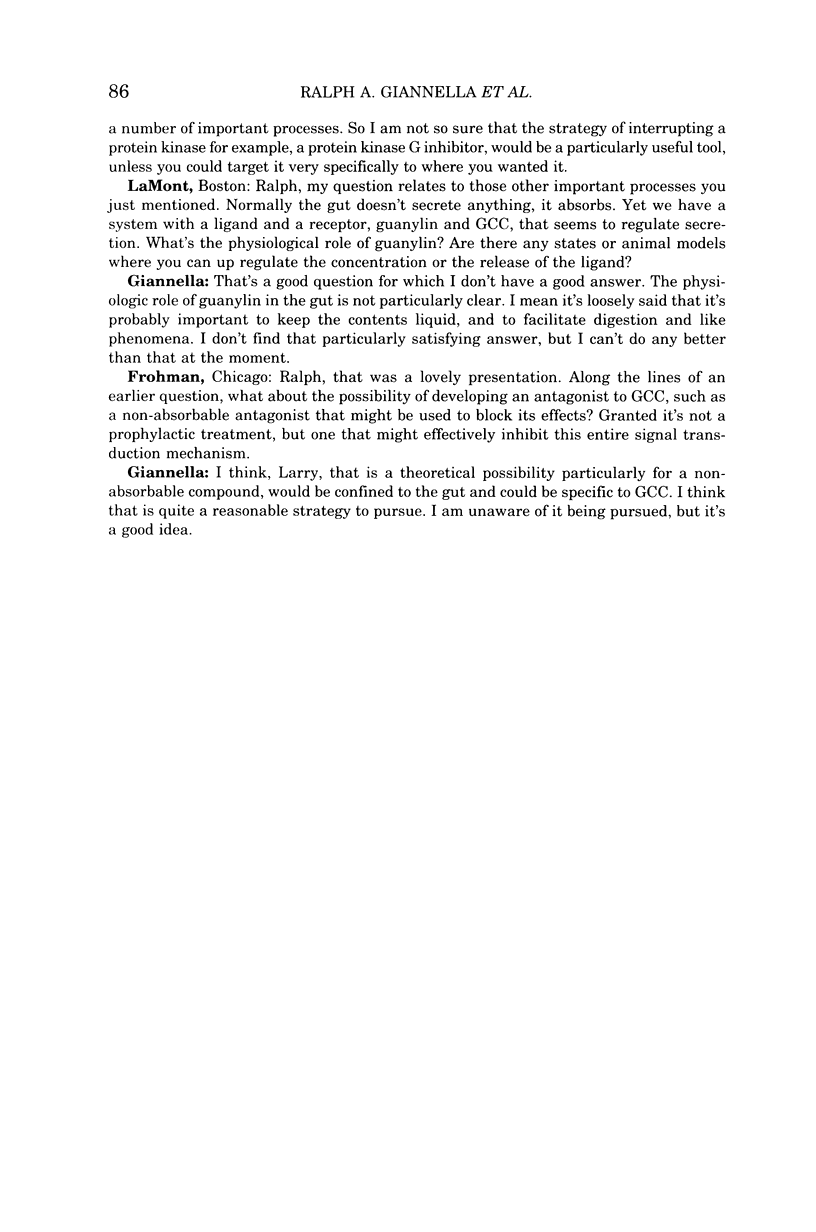
Selected References
These references are in PubMed. This may not be the complete list of references from this article.
- Albano F., Brasitus T., Mann E. A., Guarino A., Giannella R. A. Colonocyte basolateral membranes contain Escherichia coli heat-stable enterotoxin receptors. Biochem Biophys Res Commun. 2001 Jun 8;284(2):331–334. doi: 10.1006/bbrc.2001.4973. [DOI] [PubMed] [Google Scholar]
- Banik N., Ganguly U. Stimulation of phosphoinositides breakdown by the heat stable E. coli enterotoxin in rat intestinal epithelial cells. FEBS Lett. 1988 Aug 29;236(2):489–492. doi: 10.1016/0014-5793(88)80083-8. [DOI] [PubMed] [Google Scholar]
- Carrithers S. L., Barber M. T., Biswas S., Parkinson S. J., Park P. K., Goldstein S. D., Waldman S. A. Guanylyl cyclase C is a selective marker for metastatic colorectal tumors in human extraintestinal tissues. Proc Natl Acad Sci U S A. 1996 Dec 10;93(25):14827–14832. doi: 10.1073/pnas.93.25.14827. [DOI] [PMC free article] [PubMed] [Google Scholar]
- Carrithers S. L., Eber S. L., Forte L. R., Greenberg R. N. Increased urinary excretion of uroguanylin in patients with congestive heart failure. Am J Physiol Heart Circ Physiol. 2000 Feb;278(2):H538–H547. doi: 10.1152/ajpheart.2000.278.2.H538. [DOI] [PubMed] [Google Scholar]
- Carrithers S. L., Hill M. J., Johnson B. R., O'Hara S. M., Jackson B. A., Ott C. E., Lorenz J., Mann E. A., Giannella R. A., Forte L. R. Renal effects of uroguanylin and guanylin in vivo. Braz J Med Biol Res. 1999 Nov;32(11):1337–1344. doi: 10.1590/s0100-879x1999001100003. [DOI] [PubMed] [Google Scholar]
- Carrithers S. L., Jackson B. A., Cai W. Y., Greenberg R. N., Ott C. E. Site-specific effects of dietary salt intake on guanylin and uroguanylin mRNA expression in rat intestine. Regul Pept. 2002 Jul 15;107(1-3):87–95. doi: 10.1016/s0167-0115(02)00069-1. [DOI] [PubMed] [Google Scholar]
- Carrithers S. L., Parkinson S. J., Goldstein S. D., Park P. K., Urbanski R. W., Waldman S. A. Escherichia coli heat-stable enterotoxin receptors. A novel marker for colorectal tumors. Dis Colon Rectum. 1996 Feb;39(2):171–181. doi: 10.1007/BF02068072. [DOI] [PubMed] [Google Scholar]
- Carrithers S. L., Taylor B., Cai W. Y., Johnson B. R., Ott C. E., Greenberg R. N., Jackson B. A. Guanylyl cyclase-C receptor mRNA distribution along the rat nephron. Regul Pept. 2000 Nov 24;95(1-3):65–74. doi: 10.1016/s0167-0115(00)00139-7. [DOI] [PubMed] [Google Scholar]
- Chao A. C., de Sauvage F. J., Dong Y. J., Wagner J. A., Goeddel D. V., Gardner P. Activation of intestinal CFTR Cl- channel by heat-stable enterotoxin and guanylin via cAMP-dependent protein kinase. EMBO J. 1994 Mar 1;13(5):1065–1072. doi: 10.1002/j.1460-2075.1994.tb06355.x. [DOI] [PMC free article] [PubMed] [Google Scholar]
- Charney A. N., Egnor R. W., Alexander-Chacko J. T., Zaharia V., Mann E. A., Giannella R. A. Effect of E. coli heat-stable enterotoxin on colonic transport in guanylyl cyclase C receptor-deficient mice. Am J Physiol Gastrointest Liver Physiol. 2001 Feb;280(2):G216–G221. doi: 10.1152/ajpgi.2001.280.2.G216. [DOI] [PubMed] [Google Scholar]
- Cohen M. B., Guarino A., Shukla R., Giannella R. A. Age-related differences in receptors for Escherichia coli heat-stable enterotoxin in the small and large intestine of children. Gastroenterology. 1988 Feb;94(2):367–373. doi: 10.1016/0016-5085(88)90423-4. [DOI] [PubMed] [Google Scholar]
- Cohen M. B., Hawkins J. A., Witte D. P. Guanylin mRNA expression in human intestine and colorectal adenocarcinoma. Lab Invest. 1998 Jan;78(1):101–108. [PubMed] [Google Scholar]
- Cohen M. B., Jensen N. J., Hawkins J. A., Mann E. A., Thompson M. R., Lentze M. J., Giannella R. A. Receptors for Escherichia coli heat stable enterotoxin in human intestine and in a human intestinal cell line (Caco-2). J Cell Physiol. 1993 Jul;156(1):138–144. doi: 10.1002/jcp.1041560119. [DOI] [PubMed] [Google Scholar]
- Crane M. R., Hugues M., O'Hanley P. D., Waldman S. A. Identification of two affinity states of low affinity receptors for Escherichia coli heat-stable enterotoxin: correlation of occupation of lower affinity state with guanylate cyclase activation. Mol Pharmacol. 1992 Jun;41(6):1073–1080. [PubMed] [Google Scholar]
- Currie M. G., Fok K. F., Kato J., Moore R. J., Hamra F. K., Duffin K. L., Smith C. E. Guanylin: an endogenous activator of intestinal guanylate cyclase. Proc Natl Acad Sci U S A. 1992 Feb 1;89(3):947–951. doi: 10.1073/pnas.89.3.947. [DOI] [PMC free article] [PubMed] [Google Scholar]
- Cuthbert A. W., Hickman M. E., MacVinish L. J., Evans M. J., Colledge W. H., Ratcliff R., Seale P. W., Humphrey P. P. Chloride secretion in response to guanylin in colonic epithelial from normal and transgenic cystic fibrosis mice. Br J Pharmacol. 1994 May;112(1):31–36. doi: 10.1111/j.1476-5381.1994.tb13024.x. [DOI] [PMC free article] [PubMed] [Google Scholar]
- Fan X., Hamra F. K., London R. M., Eber S. L., Krause W. J., Freeman R. H., Smith C. E., Currie M. G., Forte L. R. Structure and activity of uroguanylin and guanylin from the intestine and urine of rats. Am J Physiol. 1997 Nov;273(5 Pt 1):E957–E964. doi: 10.1152/ajpendo.1997.273.5.E957. [DOI] [PubMed] [Google Scholar]
- Field M., Graf L. H., Jr, Laird W. J., Smith P. L. Heat-stable enterotoxin of Escherichia coli: in vitro effects on guanylate cyclase activity, cyclic GMP concentration, and ion transport in small intestine. Proc Natl Acad Sci U S A. 1978 Jun;75(6):2800–2804. doi: 10.1073/pnas.75.6.2800. [DOI] [PMC free article] [PubMed] [Google Scholar]
- Fonteles M. C., Greenberg R. N., Monteiro H. S., Currie M. G., Forte L. R. Natriuretic and kaliuretic activities of guanylin and uroguanylin in the isolated perfused rat kidney. Am J Physiol. 1998 Aug;275(2 Pt 2):F191–F197. doi: 10.1152/ajprenal.1998.275.2.F191. [DOI] [PubMed] [Google Scholar]
- Forte L. R., Eber S. L., Turner J. T., Freeman R. H., Fok K. F., Currie M. G. Guanylin stimulation of Cl- secretion in human intestinal T84 cells via cyclic guanosine monophosphate. J Clin Invest. 1993 Jun;91(6):2423–2428. doi: 10.1172/JCI116476. [DOI] [PMC free article] [PubMed] [Google Scholar]
- Forte L. R., London R. M., Krause W. J., Freeman R. H. Mechanisms of guanylin action via cyclic GMP in the kidney. Annu Rev Physiol. 2000;62:673–695. doi: 10.1146/annurev.physiol.62.1.673. [DOI] [PubMed] [Google Scholar]
- Forte L. R., Thorne P. K., Eber S. L., Krause W. J., Freeman R. H., Francis S. H., Corbin J. D. Stimulation of intestinal Cl- transport by heat-stable enterotoxin: activation of cAMP-dependent protein kinase by cGMP. Am J Physiol. 1992 Sep;263(3 Pt 1):C607–C615. doi: 10.1152/ajpcell.1992.263.3.C607. [DOI] [PubMed] [Google Scholar]
- French P. J., Bijman J., Edixhoven M., Vaandrager A. B., Scholte B. J., Lohmann S. M., Nairn A. C., de Jonge H. R. Isotype-specific activation of cystic fibrosis transmembrane conductance regulator-chloride channels by cGMP-dependent protein kinase II. J Biol Chem. 1995 Nov 3;270(44):26626–26631. doi: 10.1074/jbc.270.44.26626. [DOI] [PubMed] [Google Scholar]
- Gali H., Sieckman G. L., Hoffman T. J., Owen N. K., Chin D. T., Forte L. R., Volkert W. A. In vivo evaluation of an 111In-labeled ST-peptide analog for specific-targeting of human colon cancers. Nucl Med Biol. 2001 Nov;28(8):903–909. doi: 10.1016/s0969-8051(01)00276-1. [DOI] [PubMed] [Google Scholar]
- Giannella R. A. Escherichia coli heat-stable enterotoxins, guanylins, and their receptors: what are they and what do they do? J Lab Clin Med. 1995 Feb;125(2):173–181. [PubMed] [Google Scholar]
- Giannella R. A., Luttrell M., Thompson M. Binding of Escherichia coli heat-stable enterotoxin to receptors on rat intestinal cells. Am J Physiol. 1983 Oct;245(4):G492–G498. doi: 10.1152/ajpgi.1983.245.4.G492. [DOI] [PubMed] [Google Scholar]
- Giannella R. A. Pathogenesis of acute bacterial diarrheal disorders. Annu Rev Med. 1981;32:341–357. doi: 10.1146/annurev.me.32.020181.002013. [DOI] [PubMed] [Google Scholar]
- Goldstein J. L., Sahi J., Bhuva M., Layden T. J., Rao M. C. Escherichia coli heat-stable enterotoxin-mediated colonic Cl- secretion is absent in cystic fibrosis. Gastroenterology. 1994 Oct;107(4):950–956. doi: 10.1016/0016-5085(94)90218-6. [DOI] [PubMed] [Google Scholar]
- Greenberg R. N., Hill M., Crytzer J., Krause W. J., Eber S. L., Hamra F. K., Forte L. R. Comparison of effects of uroguanylin, guanylin, and Escherichia coli heat-stable enterotoxin STa in mouse intestine and kidney: evidence that uroguanylin is an intestinal natriuretic hormone. J Investig Med. 1997 Jun;45(5):276–282. [PubMed] [Google Scholar]
- Guarino A., Cohen M. B., Giannella R. A. Small and large intestinal guanylate cyclase activity in children: effect of age and stimulation by Escherichia coli heat-stable enterotoxin. Pediatr Res. 1987 Jun;21(6):551–555. doi: 10.1203/00006450-198706000-00009. [DOI] [PubMed] [Google Scholar]
- Guba M., Kuhn M., Forssmann W. G., Classen M., Gregor M., Seidler U. Guanylin strongly stimulates rat duodenal HCO3- secretion: proposed mechanism and comparison with other secretagogues. Gastroenterology. 1996 Dec;111(6):1558–1568. doi: 10.1016/s0016-5085(96)70018-5. [DOI] [PubMed] [Google Scholar]
- Hamra F. K., Fan X., Krause W. J., Freeman R. H., Chin D. T., Smith C. E., Currie M. G., Forte L. R. Prouroguanylin and proguanylin: purification from colon, structure, and modulation of bioactivity by proteases. Endocrinology. 1996 Jan;137(1):257–265. doi: 10.1210/endo.137.1.8536621. [DOI] [PubMed] [Google Scholar]
- Hamra F. K., Forte L. R., Eber S. L., Pidhorodeckyj N. V., Krause W. J., Freeman R. H., Chin D. T., Tompkins J. A., Fok K. F., Smith C. E. Uroguanylin: structure and activity of a second endogenous peptide that stimulates intestinal guanylate cyclase. Proc Natl Acad Sci U S A. 1993 Nov 15;90(22):10464–10468. doi: 10.1073/pnas.90.22.10464. [DOI] [PMC free article] [PubMed] [Google Scholar]
- Hasegawa M., Hidaka Y., Matsumoto Y., Sanni T., Shimonishi Y. Determination of the binding site on the extracellular domain of guanylyl cyclase C to heat-stable enterotoxin. J Biol Chem. 1999 Oct 29;274(44):31713–31718. doi: 10.1074/jbc.274.44.31713. [DOI] [PubMed] [Google Scholar]
- Hirayama T., Noda M., Ito H., Takeda Y. Stimulation of phosphorylation of rat brush-border membrane proteins by Escherichia coli heat-stable enterotoxin, cholera enterotoxin and cyclic nucleotides, and its inhibition by protein kinase inhibitors, isoquinolinesulfonamides. Microb Pathog. 1990 Jun;8(6):421–431. doi: 10.1016/0882-4010(90)90029-p. [DOI] [PubMed] [Google Scholar]
- Hirayama T., Wada A., Iwata N., Takasaki S., Shimonishi Y., Takeda Y. Glycoprotein receptors for a heat-stable enterotoxin (STh) produced by enterotoxigenic Escherichia coli. Infect Immun. 1992 Oct;60(10):4213–4220. doi: 10.1128/iai.60.10.4213-4220.1992. [DOI] [PMC free article] [PubMed] [Google Scholar]
- Kita T., Smith C. E., Fok K. F., Duffin K. L., Moore W. M., Karabatsos P. J., Kachur J. F., Hamra F. K., Pidhorodeckyj N. V., Forte L. R. Characterization of human uroguanylin: a member of the guanylin peptide family. Am J Physiol. 1994 Feb;266(2 Pt 2):F342–F348. doi: 10.1152/ajprenal.1994.266.2.F342. [DOI] [PubMed] [Google Scholar]
- Krause W. J., Cullingford G. L., Freeman R. H., Eber S. L., Richardson K. C., Fok K. F., Currie M. G., Forte L. R. Distribution of heat-stable enterotoxin/guanylin receptors in the intestinal tract of man and other mammals. J Anat. 1994 Apr;184(Pt 2):407–417. [PMC free article] [PubMed] [Google Scholar]
- Kuhn M., Adermann K., Jähne J., Forssmann W. G., Rechkemmer G. Segmental differences in the effects of guanylin and Escherichia coli heat-stable enterotoxin on Cl- secretion in human gut. J Physiol. 1994 Sep 15;479(Pt 3):433–440. doi: 10.1113/jphysiol.1994.sp020307. [DOI] [PMC free article] [PubMed] [Google Scholar]
- Kuhn M., Kulaksiz H., Adermann K., Rechkemmer G., Forssmann W. G. Radioimmunoassay for circulating human guanylin. FEBS Lett. 1994 Mar 21;341(2-3):218–222. doi: 10.1016/0014-5793(94)80460-5. [DOI] [PubMed] [Google Scholar]
- Kuhn M., Kulaksiz H., Cetin Y., Frank M., Nold R., Arnold R., Böker K., Bischoff S. C., Manns M. P., Forssmann W. G. Circulating and tissue guanylin immunoreactivity in intestinal secretory diarrhoea. Eur J Clin Invest. 1995 Dec;25(12):899–905. doi: 10.1111/j.1365-2362.1995.tb01964.x. [DOI] [PubMed] [Google Scholar]
- Kulaksiz H., Cetin Y. Uroguanylin and guanylate cyclase C in the human pancreas: expression and mutuality of ligand/receptor localization as indicators of intercellular paracrine signaling pathways. J Endocrinol. 2001 Jul;170(1):267–275. doi: 10.1677/joe.0.1700267. [DOI] [PubMed] [Google Scholar]
- Kulaksiz H., Rausch U., Vaccaro R., Renda T. G., Cetin Y. Guanylin and uroguanylin in the parotid and submandibular glands: potential intrinsic regulators of electrolyte secretion in salivary glands. Histochem Cell Biol. 2001 Jun;115(6):527–533. doi: 10.1007/s004180100281. [DOI] [PubMed] [Google Scholar]
- Kulaksiz H., Schmid A., Hönscheid M., Eissele R., Klempnauer J., Cetin Y. Guanylin in the human pancreas: a novel luminocrine regulatory pathway of electrolyte secretion via cGMP and CFTR in the ductal system. Histochem Cell Biol. 2001 Feb;115(2):131–145. doi: 10.1007/s004180000244. [DOI] [PubMed] [Google Scholar]
- Kulaksiz Hasan, Cetin Yalcin. The electrolyte/fluid secretion stimulatory peptides guanylin and uroguanylin and their common functional coupling proteins in the rat pancreas: a correlative study of expression and cell-specific localization. Pancreas. 2002 Aug;25(2):170–175. doi: 10.1097/00006676-200208000-00010. [DOI] [PubMed] [Google Scholar]
- Laney D. W., Jr, Bezerra J. A., Kosiba J. L., Degen S. J., Cohen M. B. Upregulation of Escherichia coli heat-stable enterotoxin receptor in regenerating rat liver. Am J Physiol. 1994 May;266(5 Pt 1):G899–G906. doi: 10.1152/ajpgi.1994.266.5.G899. [DOI] [PubMed] [Google Scholar]
- Laney D. W., Jr, Mann E. A., Dellon S. C., Perkins D. R., Giannella R. A., Cohen M. B. Novel sites for expression of an Escherichia coli heat-stable enterotoxin receptor in the developing rat. Am J Physiol. 1992 Nov;263(5 Pt 1):G816–G821. doi: 10.1152/ajpgi.1992.263.5.G816. [DOI] [PubMed] [Google Scholar]
- Mann E. A., Cohen M. B., Giannella R. A. Comparison of receptors for Escherichia coli heat-stable enterotoxin: novel receptor present in IEC-6 cells. Am J Physiol. 1993 Jan;264(1 Pt 1):G172–G178. doi: 10.1152/ajpgi.1993.264.1.G172. [DOI] [PubMed] [Google Scholar]
- Mann E. A., Jump M. L., Wu J., Yee E., Giannella R. A. Mice lacking the guanylyl cyclase C receptor are resistant to STa-induced intestinal secretion. Biochem Biophys Res Commun. 1997 Oct 20;239(2):463–466. doi: 10.1006/bbrc.1997.7487. [DOI] [PubMed] [Google Scholar]
- Markert T., Vaandrager A. B., Gambaryan S., Pöhler D., Häusler C., Walter U., De Jonge H. R., Jarchau T., Lohmann S. M. Endogenous expression of type II cGMP-dependent protein kinase mRNA and protein in rat intestine. Implications for cystic fibrosis transmembrane conductance regulator. J Clin Invest. 1995 Aug;96(2):822–830. doi: 10.1172/JCI118128. [DOI] [PMC free article] [PubMed] [Google Scholar]
- Martin S., Adermann K., Forssmann W. G., Kuhn M. Regulated, side-directed secretion of proguanylin from isolated rat colonic mucosa. Endocrinology. 1999 Nov;140(11):5022–5029. doi: 10.1210/endo.140.11.7103. [DOI] [PubMed] [Google Scholar]
- Nataro J. P., Kaper J. B. Diarrheagenic Escherichia coli. Clin Microbiol Rev. 1998 Jan;11(1):142–201. doi: 10.1128/cmr.11.1.142. [DOI] [PMC free article] [PubMed] [Google Scholar]
- Park Jason, Schulz Stephanie, Haaf Janis, Kairys John C., Waldman Scott A. Ectopic expression of guanylyl cyclase C in adenocarcinomas of the esophagus and stomach. Cancer Epidemiol Biomarkers Prev. 2002 Aug;11(8):739–744. [PubMed] [Google Scholar]
- Pfeifer A., Aszódi A., Seidler U., Ruth P., Hofmann F., Fässler R. Intestinal secretory defects and dwarfism in mice lacking cGMP-dependent protein kinase II. Science. 1996 Dec 20;274(5295):2082–2086. doi: 10.1126/science.274.5295.2082. [DOI] [PubMed] [Google Scholar]
- Pitari G. M., Di Guglielmo M. D., Park J., Schulz S., Waldman S. A. Guanylyl cyclase C agonists regulate progression through the cell cycle of human colon carcinoma cells. Proc Natl Acad Sci U S A. 2001 Jul 3;98(14):7846–7851. doi: 10.1073/pnas.141124698. [DOI] [PMC free article] [PubMed] [Google Scholar]
- Potthast R., Ehler E., Scheving L. A., Sindic A., Schlatter E., Kuhn M. High salt intake increases uroguanylin expression in mouse kidney. Endocrinology. 2001 Jul;142(7):3087–3097. doi: 10.1210/endo.142.7.8274. [DOI] [PubMed] [Google Scholar]
- Savarino S. J., Fasano A., Watson J., Martin B. M., Levine M. M., Guandalini S., Guerry P. Enteroaggregative Escherichia coli heat-stable enterotoxin 1 represents another subfamily of E. coli heat-stable toxin. Proc Natl Acad Sci U S A. 1993 Apr 1;90(7):3093–3097. doi: 10.1073/pnas.90.7.3093. [DOI] [PMC free article] [PubMed] [Google Scholar]
- Scheving L. A., Russell W. E., Chong K. M. Structure, glycosylation, and localization of rat intestinal guanylyl cyclase C: modulation by fasting. Am J Physiol. 1996 Dec;271(6 Pt 1):G959–G968. doi: 10.1152/ajpgi.1996.271.6.G959. [DOI] [PubMed] [Google Scholar]
- Scheving L. A., Russell W. E. Guanylyl cyclase C is up-regulated by nonparenchymal cells and hepatocytes in regenerating rat liver. Cancer Res. 1996 Nov 15;56(22):5186–5191. [PubMed] [Google Scholar]
- Schulz S., Green C. K., Yuen P. S., Garbers D. L. Guanylyl cyclase is a heat-stable enterotoxin receptor. Cell. 1990 Nov 30;63(5):941–948. doi: 10.1016/0092-8674(90)90497-3. [DOI] [PubMed] [Google Scholar]
- Schulz S., Lopez M. J., Kuhn M., Garbers D. L. Disruption of the guanylyl cyclase-C gene leads to a paradoxical phenotype of viable but heat-stable enterotoxin-resistant mice. J Clin Invest. 1997 Sep 15;100(6):1590–1595. doi: 10.1172/JCI119683. [DOI] [PMC free article] [PubMed] [Google Scholar]
- Scott Robert O., Thelin William R., Milgram Sharon L. A novel PDZ protein regulates the activity of guanylyl cyclase C, the heat-stable enterotoxin receptor. J Biol Chem. 2002 Apr 11;277(25):22934–22941. doi: 10.1074/jbc.M202434200. [DOI] [PubMed] [Google Scholar]
- Shailubhai K., Yu H. H., Karunanandaa K., Wang J. Y., Eber S. L., Wang Y., Joo N. S., Kim H. D., Miedema B. W., Abbas S. Z. Uroguanylin treatment suppresses polyp formation in the Apc(Min/+) mouse and induces apoptosis in human colon adenocarcinoma cells via cyclic GMP. Cancer Res. 2000 Sep 15;60(18):5151–5157. [PubMed] [Google Scholar]
- Sindiće Aleksandra, Başoglu Candan, Cerçi Ayhan, Hirsch Jochen R., Potthast Regine, Kuhn Michaela, Ghanekar Yashoda, Visweswariah Sandhya S., Schlatter Eberhard. Guanylin, uroguanylin, and heat-stable euterotoxin activate guanylate cyclase C and/or a pertussis toxin-sensitive G protein in human proximal tubule cells. J Biol Chem. 2002 Mar 21;277(20):17758–17764. doi: 10.1074/jbc.M110627200. [DOI] [PubMed] [Google Scholar]
- Staples S. J., Asher S. E., Giannella R. A. Purification and characterization of heat-stable enterotoxin produced by a strain of E. coli pathogenic for man. J Biol Chem. 1980 May 25;255(10):4716–4721. [PubMed] [Google Scholar]
- Steinbrecher K. A., Tuohy T. M., Heppner Goss K., Scott M. C., Witte D. P., Groden J., Cohen M. B. Expression of guanylin is downregulated in mouse and human intestinal adenomas. Biochem Biophys Res Commun. 2000 Jun 24;273(1):225–230. doi: 10.1006/bbrc.2000.2917. [DOI] [PubMed] [Google Scholar]
- Sullivan S. K., Agellon L. B., Schick R. Identification and partial characterization of a domain in CFTR that may bind cyclic nucleotides directly. Curr Biol. 1995 Oct 1;5(10):1159–1167. doi: 10.1016/s0960-9822(95)00232-6. [DOI] [PubMed] [Google Scholar]
- Swenson E. S., Mann E. A., Jump M. L., Witte D. P., Giannella R. A. The guanylin/STa receptor is expressed in crypts and apical epithelium throughout the mouse intestine. Biochem Biophys Res Commun. 1996 Aug 23;225(3):1009–1014. doi: 10.1006/bbrc.1996.1286. [DOI] [PubMed] [Google Scholar]
- Tien X. Y., Brasitus T. A., Kaetzel M. A., Dedman J. R., Nelson D. J. Activation of the cystic fibrosis transmembrane conductance regulator by cGMP in the human colonic cancer cell line, Caco-2. J Biol Chem. 1994 Jan 7;269(1):51–54. [PubMed] [Google Scholar]
- Vaandrager A. B., van der Wiel E., Hom M. L., Luthjens L. H., de Jonge H. R. Heat-stable enterotoxin receptor/guanylyl cyclase C is an oligomer consisting of functionally distinct subunits, which are non-covalently linked in the intestine. J Biol Chem. 1994 Jun 10;269(23):16409–16415. [PubMed] [Google Scholar]
- Vaandrager Arie B. Structure and function of the heat-stable enterotoxin receptor/guanylyl cyclase C. Mol Cell Biochem. 2002 Jan;230(1-2):73–83. [PubMed] [Google Scholar]
- Wada A., Hirayama T., Kitaura H., Fujisawa J., Hasegawa M., Hidaka Y., Shimonishi Y. Identification of ligand recognition sites in heat-stable enterotoxin receptor, membrane-associated guanylyl cyclase C by site-directed mutational analysis. Infect Immun. 1996 Dec;64(12):5144–5150. doi: 10.1128/iai.64.12.5144-5150.1996. [DOI] [PMC free article] [PubMed] [Google Scholar]
- Wedel B., Garbers D. The guanylyl cyclase family at Y2K. Annu Rev Physiol. 2001;63:215–233. doi: 10.1146/annurev.physiol.63.1.215. [DOI] [PubMed] [Google Scholar]
- Whitaker T. L., Witte D. P., Scott M. C., Cohen M. B. Uroguanylin and guanylin: distinct but overlapping patterns of messenger RNA expression in mouse intestine. Gastroenterology. 1997 Sep;113(3):1000–1006. doi: 10.1016/s0016-5085(97)70197-5. [DOI] [PubMed] [Google Scholar]
- Wiegand R. C., Kato J., Currie M. G. Rat guanylin cDNA: characterization of the precursor of an endogenous activator of intestinal guanylate cyclase. Biochem Biophys Res Commun. 1992 Jun 30;185(3):812–817. doi: 10.1016/0006-291x(92)91699-q. [DOI] [PubMed] [Google Scholar]
- Wolfe Henry R., Mendizabal Marivi, Lleong Elinor, Cuthbertson Alan, Desai Vinay, Pullan Shirley, Fujii Dennis K., Morrison Matthew, Pither Richard, Waldman Scott A. In vivo imaging of human colon cancer xenografts in immunodeficient mice using a guanylyl cyclase C--specific ligand. J Nucl Med. 2002 Mar;43(3):392–399. [PubMed] [Google Scholar]
- Wong S. K., Garbers D. L. Receptor guanylyl cyclases. J Clin Invest. 1992 Aug;90(2):299–305. doi: 10.1172/JCI115862. [DOI] [PMC free article] [PubMed] [Google Scholar]
- de Jonge H. R. The mechanism of action of Escherichia coli heat-stable toxin. Biochem Soc Trans. 1984 Apr;12(2):180–184. doi: 10.1042/bst0120180. [DOI] [PubMed] [Google Scholar]
- de Sauvage F. J., Horuk R., Bennett G., Quan C., Burnier J. P., Goeddel D. V. Characterization of the recombinant human receptor for Escherichia coli heat-stable enterotoxin. J Biol Chem. 1992 Apr 5;267(10):6479–6482. [PubMed] [Google Scholar]


